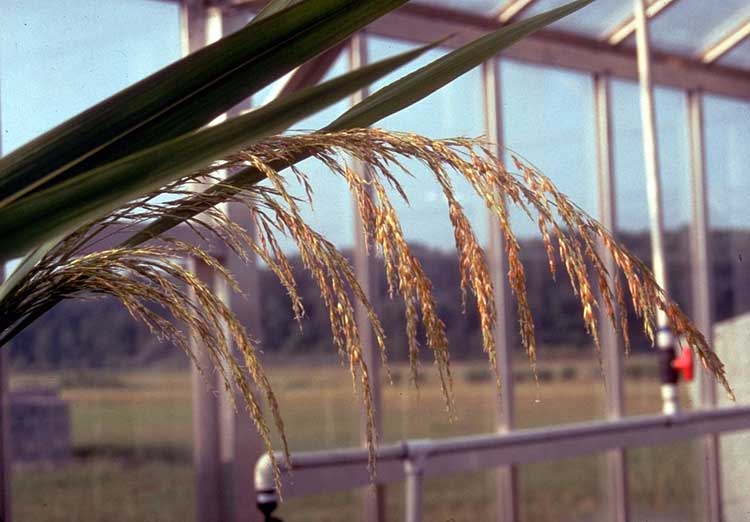
Zizaniopsis miliacea, Photo courtesy of USDA NRCS.
Classification System: APG IV
Superregnum: Eukaryota
Regnum: Plantae
Cladus: Angiosperms
Cladus: Monocots
Cladus: Commelinids
Ordo: Poales
Familia: Poaceae
Subfamilia: Oryzoideae
Tribus: Oryzeae
Subtribus: Zizaniinae
Genus: Zizaniopsis
Species: Zizaniopsis miliacea
Name
Zizaniopsis miliacea (Michx.) Doll & Asch.
References
C. F. P. von Martius, Fl. bras. 2:13. 1871
USDA, ARS, Germplasm Resources Information Network. Zizaniopsis miliacea in the Germplasm Resources Information Network (GRIN), U.S. Department of Agriculture Agricultural Research Service. Accessed: 07-Oct-06.
Vernacular names
English: giant cutgrass
Zizaniopsis miliacea is a species of flowering plant in the grass family, Poaceae.[2] It is known by the common names giant cutgrass, water millet, and southern wildrice. The name giant cutgrass refers to the plant's large, rough-edged leaves, and the name southern wildrice refers to its resemblance to wildrice (Zizania spp.).[3] It is native to the southeastern United States and it can also be found in central Mexico.[4]
This perennial grass grows from rhizomes, producing stems up to 4 meters tall and 3.5 centimeters wide. The stems root at nodes that come in contact with the substrate.[4] It also spreads via functional stolons (decumbent rooting stems) and vegetative buds that erupt from the stems.[3][5] The blue-green leaves are up to a meter long and 3 centimeters wide. The panicles may exceed 80 centimeters long and are usually up to 20 centimeters wide.[4]
This plant grows in aquatic habitat, such as marshes and riverbanks. It is also common in former rice paddies.[3] This grass forms large colonies by spreading via its stolon-like stems and rhizomes.[5] It grows in fresh and brackish water,[4] tolerating some salt in the water. It is sometimes planted for erosion control in wetlands.[6] Large stands of the plant are sometimes considered to be a nuisance, providing "poor wildlife habitat";[7] however, it does provide nesting sites, cover, and food for animals.[8]
References
"Zizaniopsis miliacea". NatureServe Explorer. NatureServe: ELEMENT_GLOBAL.2.157142. 2015. Retrieved September 27, 2020.
"Zizaniopsis miliacea (Michx.) Döll & Asch". Plants of the World Online. The Trustees of the Royal Botanic Gardens, Kew. n.d. Retrieved September 27, 2020.
Fox, A. M. and W. T. Haller. (2000). Production and survivorship of the functional stolons of giant cutgrass, Zizaniopsis miliacea (Poaceae). Am J Bot 87(6) 811-18.
Zizaniopsis miliacea. Archived March 4, 2016, at the Wayback Machine Grass Manual Treatment.
Holmes, W. C. and D. T. Stalling. (1990). Studies on the reproductive strategy of Zizaniopsis miliacea (Michx.) Doell. & Asch. (Gramineae: Tribe Oryzeae). Castanea 55(2) 113-21.
Zizaniopsis miliacea. USDA NRCS Plant Fact Sheet.
Birch, J. B. and J. L. Cooley. (1982). Production and standing crop patterns of giant cutgrass (Zizaniopsis miliacea) in a freshwater tidal marsh. Oecologia 52(2) 230-35.
Zizaniopsis miliacea. University of Florida, IFAS.
Retrieved from "http://en.wikipedia.org/"
All text is available under the terms of the GNU Free Documentation License

